When the subject is the relative positioning of competitors across the market landscape, leadership is interested, engaged, and more than willing to debate.
Over the years, I've developed several tools for making that process of analyzing competitive messaging more accessible and empirical (less subjective), as well as more graphical and easier to understand. And it all starts with a straightforward approach to business strategy, giving us the rational basis we need for evaluating marketing messages.
Hundreds of books on competitive messaging have been published in the last decade, each offering a new twist on the subject. My preference, though, has been the well-established approach outlined by Michael Treacy and Fred Wiersema in The Discipline of Market Leaders, which adapts Harvard guru Michael Porter's Five Forces model to market positioning.
Treacy and Wiersema write that there are three "disciplines" companies can embrace in business strategy:
- Product/technology leadership, including the development of cutting-edge innovation and product performance (e.g., Apple)
- Operational excellence, or honing operations to achieve state-of-the-art capabilities in either product purity (e.g., a chemical company) or price (e.g., Walmart)
- Customer intimacy, or the ability to tailor products or services around individual customer needs (e.g., logistics with UPS)
Following Porter's advice, companies seeking to establish their positioning in the marketplace need to select one and only one of those positions. Companies can't, of course, let their services in the other areas become substandard or embarrassing. But they need to ensure they are devoting the lion's share of their resources to furthering their leadership in their chosen market discipline. That, in Porter's view, is the essence of competitive positioning.
How to Position Your Competitors in Four Steps
The following pyramid illustrates the "battlefield," if you will, on which the various competitors are arrayed. It lays out the competitive landscape around the three disciplines, creating a "map" we will use to position the players.

1. Assemble your competitor list
The first thing to do is develop a list of competitors to review. Pick the obvious ones, especially the market leaders in sales, reputation, product quality, and customer service; but also think outside the box and consider "not-in-kind competitors" who are just entering the market or obviously could.
Some of the most disruptive market entries over the past few decades have come from low-cost, low-quality market entrants. You don't want to be like the photographic film companies (e.g., Kodak) that wrote off digital photography as being too low-end.
I wouldn't list more than four or five, max.
2. Obtain their marketing materials
The next step, and usually the hardest, is obtaining marketing materials for each competitor. It's best to get emails, ads, or even sales collateral because those often focus on market positioning.
If you have access to competitive ad research companies, such as AdSpyder, SpyFu, and Media Radar, capture ad creative and estimates of advertising spend—a helpful statistic when clients are reluctant to spend as much as they should. Note: Most ad research companies require a subscription for access.
If all else fails, a competitor's websites and social media are adequate resources for analyzing market messaging. When I'm doing high-level branding research, I always look at the following:
- Homepage
- About Us page
- Any "values" pages, if the company has them
- A few product or industry pages
3. Analyze competitors' content
You could run the competitors' sites or key pages through one of the dozens of word cloud generators, such as WordClouds.com. It is certainly fun to use and sometimes shows revealing trends, especially when you use versions that also show the number of times a word is used.

My preference is to capture all the copy on the page, drop it into a Word document, and do searches to count the number of times certain words appear in the copy.
4. Crunch the data
The problem is that writers, the tricky devils they are, use synonyms to avoid repeating certain words and phrases. A typical example of product-technology leadership might be "innovation," and writers might use terms such as "cutting-edge," "advanced," "technology-leading," and others to convey similar ideas or feelings. There are also sub-themes or categories that fall under the relatively broad value disciplines mentioned previously.
That problem became strikingly obvious on one occasion when a client meeting with 12 people resulted in at least 10 different "positions" being proposed for the company. After a day-long strategy session, our positioning landscape looked something like this:

To fix the problem, I developed a graphic to create a broader semantic view of the value disciplines, grouping words or phrases that are similar or closely aligned:
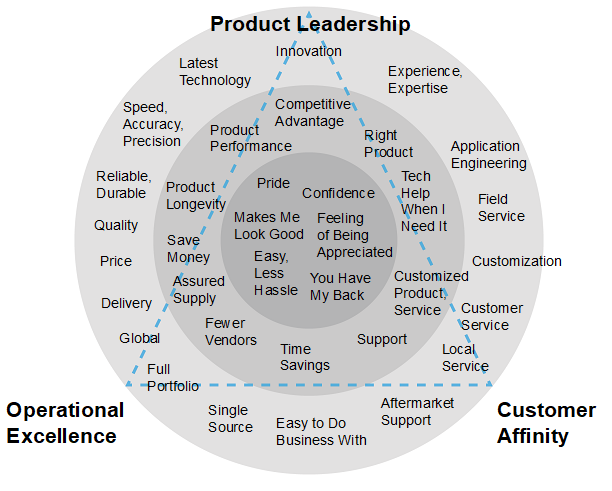
That allowed us to see that the 12 positioning statements we had been given during the strategy session were not all over the block. They had, in fact, staked out a product/technology leadership positioning:
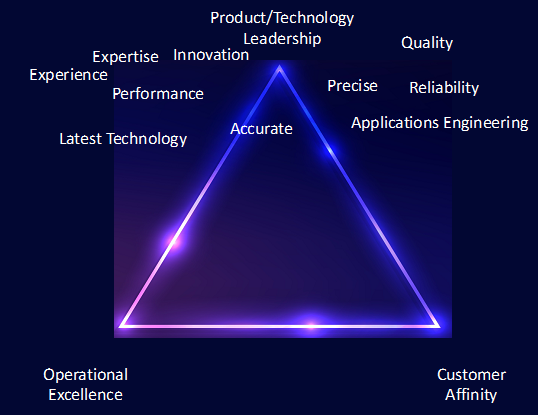
That allowed us to analyze a competitor's marketing materials, especially its website, to determine how that company positions itself with its promotional materials. I do adjust the semantic pyramid for different technologies and industries to follow the terminology that is popular in that segment. But the principle remains the same.
The task then becomes a simple matter of counting how many words or phrases associated with each value discipline appear in each competitor's materials. I often develop a table that may or may not be shared with the client:
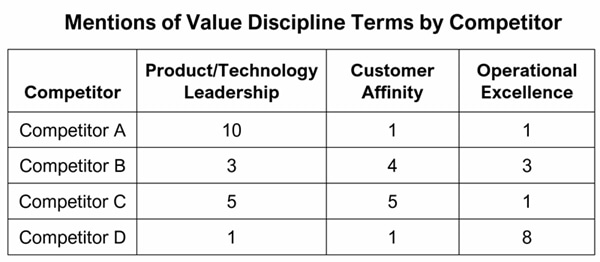
I also pick a key piece of content and highlight words or phrases that best illustrate the company's positioning:
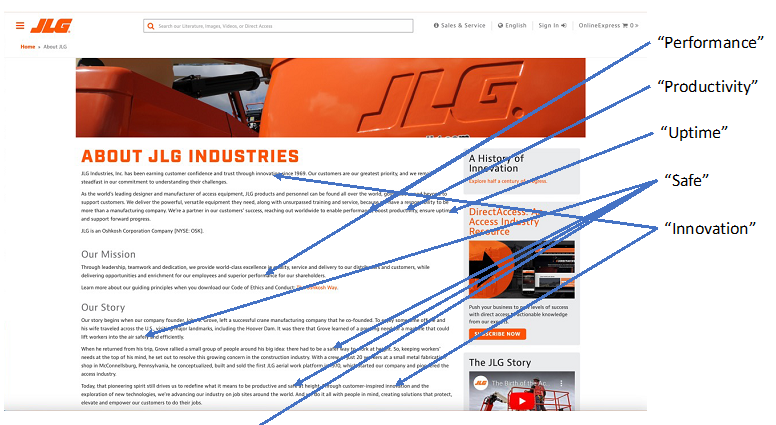
Pointing out similar phrases on important pages of a competitor's site illustrates how a competitor is positioning itself. When you use this technique, you'll usually get little pushback about whether your analysis is accurate.
Finally, going back to the landscape or "map" we created at the beginning, we can place the competitors on the positioning landscape, like this:
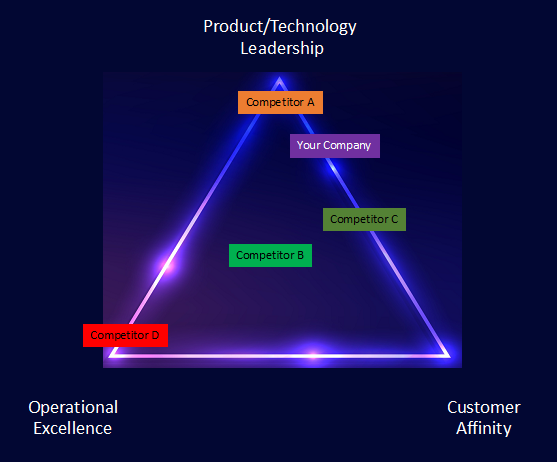
Arraying the competitive field in the competitive landscape helps company leaders see their position clearly so they can focus on making it consistent across all their published materials.
In the illustration, I should call out Competitor B, located dead center. There have been several occasions when a company has said that addressing all three positions equally would be the best strategy.
Unfortunately, that's not the case. According to Harvard strategy guru Michael Porter, Competitor B is stuck in the muddled middle, with no positioning. That means the company's customers won't know what's important to them—and their employees probably won't, either.
Will you occasionally find a competitor whose marketing claims one thing, but its salespeople or market reality establishes something different? Yes, it happens. But that is becoming less and less frequent as reality forces companies to be more consistent in their positioning. Because confusing your audience is not an effective strategy.
Using Competitive Positioning
Knowing the relative arrangement of your company's and its competitors' positions on the market landscape helps you shape the content you will use for all your marketing materials, from ads and webpages to search ads, email, and even public relations materials.
Depending on which value discipline your company emphasizes, do the following:
- Product/technology leadership. Talk about the performance and advanced technology of your offerings. Measures of speed, distance, longevity, durability, and strength are important.
- Operational excellence. Lead with pricing (for low-cost operations) or measurements of purity (for companies using their operational prowess to deliver industry-leading quality).
- Customer affinity. Show how your product or service is customized for every application. Many customer affinity marketers will find that case histories or testimonials are critical in helping to establish the product's or service's unique adaptation to each customer's situation.
Technology leaders can talk about customization or levels of purity. But they generally won't want to focus on those benefits lest they confuse their audience. Better to let those advantages appear in the body copy. Or, even better, let sales representatives make those points, especially when they deal with customers who ask about or seem interested in those topics.
* * *
Knowing where you fit and where the other players are coming from is a huge advantage in marketing. You can establish differentiation, setting your company apart from the competition, and you can develop consistency—a voice that resonates with customers and makes it easier for your own people to present and explain your product offering.
Plus, having employees know they work for a market leader in product technology, customer affinity, or operational excellence and quality? And having friends and family know that they work for that kind of company? That's priceless.
More Resources on Analyzing Competitive Messaging and Positioning
Knowing How Your Competitors Are Positioned: The Key to Competitive Intelligence




